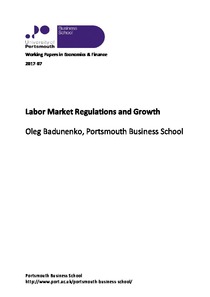Labor market regulations and growth

University of Portsmouth. Portsmouth Business School
University of Portsmouth - Portsmouth
2017
33 p.
labour market policy ; regulation ; labour productivity ; international
Working Papers on Economics & Finance
2017-07
Labour market
https://ideas.repec.org/s/pbs/ecofin.html
English
Bibliogr.
"This chapter builds a model in which labor market regulations influence labor productivity growth through labor market. The proposed model decomposes labor productivity growth into components attributable to (i) change in efficiency, (ii) technological change, (iii) physical capital deepening, (iv) human capital accumulation, and (v) labor market regulations change. The empirical analysis using data from the Penn World Tables and Economic Freedom of the World Data is performed for 1970-1995 and 1995-2014. The findings can be summarized as follows. First, physical capital deepening is the major driving force behind productivity growth over the entire period. Labor market regulations change contributing next to nothing during 1970-1995, becomes second most important force of economic growth after 1995. Second, relatively rich nations benefit more from labor market regulations change than relatively poor nations. Finally, the contribution of labor market regulations change to growth is stronger for countries with less liberalized labor markets."
Digital
The ETUI is co-funded by the European Union. Views and opinions expressed are however those of the author(s) only and do not necessarily reflect those of the European Union or the ETUI.